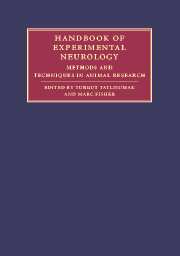Book contents
- Frontmatter
- Contents
- List of contributors
- Part I Principles and general methods
- Part II Experimental models of major neurological diseases
- 18 Focal brain ischemia models in rodents
- 19 Rodent models of global cerebral ischemia
- 20 Rodent models of hemorrhagic stroke
- 21 In vivo models of traumatic brain injury
- 22 Experimental models for the study of CNS tumors
- 23 Experimental models for demyelinating diseases
- 24 Animal models of Parkinson's disease
- 25 Animal models of epilepsy
- 26 Experimental models of hydrocephalus
- 27 Rodent models of experimental bacterial infections in the CNS
- 28 Experimental models of motor neuron disease/amyotrophic lateral sclerosis
- 29 Animal models for sleep disorders
- 30 Experimental models of muscle diseases
- Index
- References
30 - Experimental models of muscle diseases
Published online by Cambridge University Press: 04 November 2009
- Frontmatter
- Contents
- List of contributors
- Part I Principles and general methods
- Part II Experimental models of major neurological diseases
- 18 Focal brain ischemia models in rodents
- 19 Rodent models of global cerebral ischemia
- 20 Rodent models of hemorrhagic stroke
- 21 In vivo models of traumatic brain injury
- 22 Experimental models for the study of CNS tumors
- 23 Experimental models for demyelinating diseases
- 24 Animal models of Parkinson's disease
- 25 Animal models of epilepsy
- 26 Experimental models of hydrocephalus
- 27 Rodent models of experimental bacterial infections in the CNS
- 28 Experimental models of motor neuron disease/amyotrophic lateral sclerosis
- 29 Animal models for sleep disorders
- 30 Experimental models of muscle diseases
- Index
- References
Summary
Introduction
The body harbors a complex muscle system, in which individual muscles can be identified by their size, position, shape, function, and attachments. The skeletal muscles are striated and voluntary, highly specialized muscles, which attach to bones via tendons, have a specific anatomical position and innervation, and move the skeleton. Cardiac muscle is of a unique kind, striated and of involuntary type. The smooth muscle is also involuntary, and moves the bowel, modifies vessels, and constricts the bladder, to name just a few of its functions. By muscle diseases, one usually means diseases affecting the skeletal muscle, and experimental research on this muscle type is the focus of this chapter.
Diseases of muscle may result from a range of defects, from developmental defects to those in structural backbone proteins and energy metabolism. Research clarifying the nature of defects in muscle diseases has been a valuable source of information for understanding normal muscle function. Experimental muscle models can be created to study the normal function of a protein, or to study the effect of a gene mutation to clarify disease pathogenesis. Alternatively, interesting phenotypes may have arisen spontaneously in experimental animal lines, and their characterization may bring new knowledge of muscle function and diseases. Most experimental procedures concerning muscle diseases are common routine techniques of molecular biology and genetics. Therefore, in this chapter, we have concentrated on introducing those aspects of experimental muscle research that are specific for the tissue and its diseases.
- Type
- Chapter
- Information
- Handbook of Experimental NeurologyMethods and Techniques in Animal Research, pp. 544 - 561Publisher: Cambridge University PressPrint publication year: 2006



